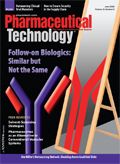Mapping Opportunities for Patent Positions
Follow-on biologics could unleash the potential of several industries and may even spark economic recovery.
The golden age of biotechnology is about to go platinum. Congress is inching closer to establishing a legal framework under which the US Food and Drug Administration can approve the marketing and sale of generic biologic compounds (follow-on biologics) much in the same way that it approves the marketing and sale of generic small-molecule drugs under the Hatch–Waxman Act.

Frances Weber
Whatever the outcome of the current data-exclusivity debate in Washington, the exact terms of the compromise will be important to only a small segment of the pharmaceutical and biotechnology industries. Of greater significance are the opportunities that lie in the development of technology that enables one to demonstrate compliance with standards for establishing similarity and equivalency between follow-on and innovator biological compounds.
The intense debate over a pathway for the approval of follow-on biologics demonstrates the importance of biotechnology to this country and the industry's potential to revolutionize medicine and agriculture. Without question, the enactment of a follow-on biologics approval pathway will unleash their potential, just as the Hatch–Waxman Act did for generic small molecules in the 1980s.

Scott D. Locke
Patents and FDA
Exclusive rights to biological inventions may be obtained under national patent systems, which enable patent holders to prevent competitors from making, using, or selling technologies that embody a claimed invention. As with small-molecule technologies, new compounds, new formulations, and new methods for the manufacture, administration, and use of biologics provide fertile grounds for obtaining patent rights for useful, new, and nonobvious inventions. In the United States, however, pharmaceuticals and biologics require FDA approval before being introduced to the market.Because no current mechanism allows follow-on biologics to receive expedited FDA review, companies that desire to produce these compounds have faced significant delays following traditional new-drug-application procedures. These companies, unlike their generic small-molecule counterparts, cannot simply piggyback on the work of the pioneering biologics companies even after a patent has expired. For patent-protected industries not regulated by FDA, this impediment does not exist.
Incentives lie ahead
If new legislation enables FDA to allow follow-on biologics to come to market faster, then competition for pioneering biologic companies will undoubtedly increase. Because time is money, economic incentives are likely to increase the number of companies that manufacture bioequivalent compounds as well as the number of follow-on biologics brought to market. Innovator companies may see a short-term decrease in profits as a result, but the change should force them to concentrate more on developing new biologics and improving their existing drugs. The combination of increased pressure on pioneer companies and increased opportunities for follow-on biologics companies may cause the biotechnology industry to be one of the first industries to emerge from the current economic downturn.
Opportunities at the door
One might be tempted to liken this situation to what happened after the Hatch–Waxman legislation passed 25 years ago, but such an analogy does not reflect the complexity of manufacturing biologics or the quantum leaps in knowledge that have occurred over the past quarter-century. We now know exponentially more about molecules and how to study them. We also have better and faster tools with which to develop new products. If a follow-on biologics regulatory pathway is approved, companies that want to come out on top will quickly need to stake out a patent position in one or more of the following technology spaces.
Bioequivalence testing. Improved methods and apparatuses to fully depict the composition and structure of a biologic as well as its performance are urgently needed. This need includes new and better assays for identifying clinically meaningful differences between two products and establishing bioequivalence or "similarity." As these technologies become more sensitive, FDA and the public would be remiss for not requiring companies that want to produce follow-on biologic compositions to employ them.
Manufaturing methods. There will be an incentive to develop new and better manufacturing methods that ensure more effective products. The inventors of new manufacturing methods are not necessarily the same individuals who discover that a composition may be useful. For example, a biologic company may obtain a patent for its biologic compound but then license in another party's method of manufacture to make a consistent product. To the extent that the method is useful for more than one product, the owner of the patented method could generate licensing revenues from multiple parties. Moreover, even if the maker of the follow-on biologic could avoid infringing the pioneer patent holder's rights and wait out the data exclusivity period, it may still need a license from a third party to manufacture its follow-on product.
Delivery systems. Renewed focus will be placed on delivery systems. Delivery of therapeutics is challenging regardless of whether the active material is a small molecule or a biologic. The efficacy of a biologic is tied to its delivery to a target tissue. Unlike the delivery of small molecules, however, there is a much shorter history of developing effective systems, and subtle changes in manufacturing may have a substantial effect on delivery. Thus, the companies that patent new delivery systems may be able to profit as much as, if not more than, the innovator biologic and follow-on biologic players.
Diagnostics. New and more effective methods for screening and diagnosing conditions that can be treated by biologics are likely to develop. One might expect many of the inventors who develop these techniques to be the same as those who develop the techniques for conditions currently treated by small-molecule drugs.
Bioinformatics. The bioinformatics industry will have the opportunity to grow. The patent landscape of this industry is the most difficult to foresee because the way these inventions are patented is rapidly changing. The opportunity to capitalize on the wealth of biodata is undisputable. But as pioneering and follow-on players feel the pressure and opportunity to grow, companies will need to monitor data pertaining to therapeutic processes and reactions. In addition, industry players will need to consider applications tailored to individual genomes and histories.
Each of these five areas could develop into a highly lucrative industry and, as with any shift in business rules, an official regulatory framework for follow-on biologics could change the competitive landscape. That said, biotechnology will always be shaped, in part, by patent positions. Thus, with a host of opportunities in the technologies that supplement the development of new therapeutics, and the ability to obtain strong patent positions on these areas, biotechnology may be the industry to lead America out of the recession.
Frances Weber, Esq., is executive vice-president of Article One Partners, a patent prior art research provider, tel. 347.838.0618, FWeber@articleonepartners.com, and Scott D. Locke, Esq., is a partner at Kalow & Springut and an adjunct law professor at Seton Hall University, tel. 212.813.1600, slocke@creativity-law.com

PacBio Chosen as Tech Partner for Global Alzheimer’s Disease Research Project
April 23rd 2025The project, the North African Dementia Registry, will unite multiple entities for the purpose of developing a comprehensive dataset to advance the research community’s understanding of Alzheimer’s disease and other dementias in diverse populations.